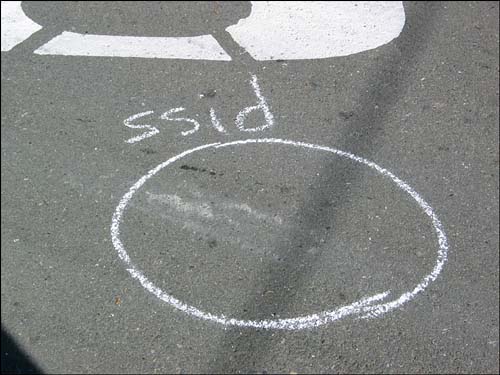| War driving is the hobby of popping in a car and cruising around with a Wi-Fi equipped laptop looking for open Wi-Fi nodes. War chalking is the act of using specific chalk markings, usually on a sidewalk, to identify Wi-Fi hotspots. Both activities show the extent to which Wi-Fi has come out of nothing as a disruptive technology, until fairly recently because of grassroots support and without the backing of major corporations. Although important companies such as Intel and others now back Wi-Fi, the "counter-culture" roots of old-time Wi-Fi and 802.11 practitioners remain an important aspect of the social history of Wi-Fi. War driving as an activity ranges from the fun, but harmless (that is, if you find this kind of thing fun) to malicious and felonious (theft of information such as credit card numbers, and industrial spying). It's successful only because an astoundingly large number of corporations and others that deploy private Wi-Fi networks do not use even rudimentary protection such as encryption. (See Chapter 19 for advice about securing your private network.) It has been estimated that as many as 60% of the privately deployed Wi-Fi networks operate without encryption. Supposedly, war chalking is derived in part from the marks hobos made during the Great Depression. These hobo chalk markings would point out a place to get a meal for free, a good place to sleep, and perhaps a particularly nasty railroad "bull." In war chalking, an open node (public hotspot) is indicated by two opposing half circles marked with the SSID and the bandwidth (see Figure 11.12). Figure 11.12. The war chalk marking for an open node.4 
A closed node (or private Wi-Fi network) is shown as a circle, along with its SSID, as in Figure 11.13. Figure 11.13. The war chalk marking for a closed node is a circle. 
A Wi-Fi node protected by WEP encryption is shown as a circle with a letter W within it (see Figure 11.14). Ideally, the encrypted node is marked with SSID, bandwidth, and access contact (the access contact can provide the encryption key if it is appropriate). Figure 11.14. The war chalk marking for a WEP node. 
The fact that war chalking has spread as a practice is a testament to the power of the Internet to spread social habits. It also speaks to the problem of finding Wi-Fi hotspots if you are not already online. In the future, it's likely that Wi-Fi hotspot information will become more ubiquitous. Perhaps the community welcome signs that now tell the time and place for Rotary Club meetings will soon come to also provide Wi-Fi hotspot information. When travelers visiting a community can find Wi-Fi hotspot information in this kind of way, war chalking will probably fade into history like the chalk marks made by the hobos of long ago. WHERE DOES THE "WAR" IN "WAR DRIVING" AND "WAR CHALKING" COME FROM? Why does "war driving" use the term "war?" Admittedly, the practice of war driving is an attempt to obtain information illicitly, but a better term might be something like "Eavesdrop driving." The term "war chalking" seems to have come along as a Johnny-come-lately term for "war driving." War driving was already firmly entrenched in the Wi-Fi counter-culture, so when the newer grass-roots activity of marking Wi-Fi hotspots came along, perhaps it seemed natural to use the "war" word. But how was "war driving" named in the first place? The term derives from "war dialing," which was the pre-broadband hacker practice of programming a computer to dial hundreds of dial-up access numbers, hoping to find one that was not protected (or could easily be cracked). It was popularized by the movie War Games (1983). |
The Absolute Minimum Here are the key points to remember from this chapter: There is no one single good way to locate all Wi-Fi hotspots. Online directories are a great source of information about Wi-Fi hotspots and are central to the Wi-Fi movement. It's problematic finding Wi-Fi hotspot information if you are not already online. Solutions range from asking people, to using a Wi-Fi Finder, to reading war chalk marks. Besides being a wireless protocol, Wi-Fi is a way of life, and a cultural movement!
|
|